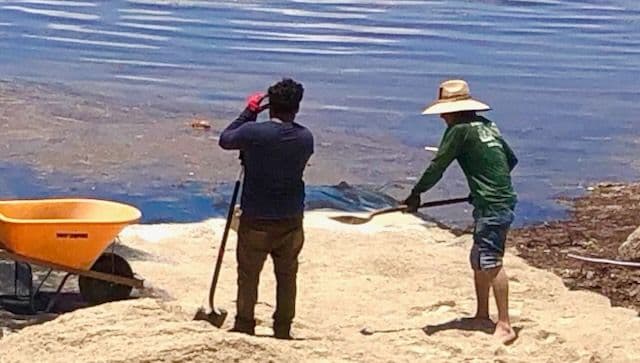Muck & Lake Weed Control - Green & Guaranteed!
Free shipping in USA (lower 48 states), Canada (almost free) & EU
Muck & Lake Weed Control - Green & Guaranteed!
Free shipping in USA (lower 48 states), Canada (almost free) & EU
Why You Should NEVER EVER Use Tarps in a Lake
Many DIYers, attempt to create a better lake bottom by laying a plastic tarp on the lakebed — then dump sand on top, and call it good.
This isn’t just a bad idea—it’s a disaster waiting to happen!
At first, the sand sits on the plastic tarp, and it looks pretty good — the weeds are buried and the bottom seems firm. But their tarps do what tarps are made to do: prevent water and gases from permeating through it. And this is where the nightmare begins.
Impending Disaster Beneath the Surface
A “Dead Zone” Forms
A plastic tarp may seem like a good idea, but what it actually does is trap toxic gases beneath it in, creating a toxic time bomb.
As organic matter—dead weeds, leaves, algae—continues decomposing under the tarp, it uses up all the oxygen while creating dangerous gases like methane, carbon dioxide — and deadly hydrogen sulfide.
Imagine an atmosphere of just methane, carbon dioxide and hydrogen sulfide. What could possibly live in it? NOTHING NORMAL!
A limnologist (lake biologist) once showed me photos of microbes found in such unnatural environments — they look like monsters from a Sci-Fi Horror movie. “Nature abhors a vacuum,” he said, “so some exotic organisms move in — organisms you don’t want anywhere near you.”
As gas pressure builds underneath, the tarp starts rising — the same way gases cause hot air balloons to rise.
As the tarp rises, sand begins sliding off the slippery tarp. The once-promising beach project becomes a potentially live-threatening disaster.

Eventually, the increasing pressure from trapped gases causes the tarp to detach from the bottom. Toxic gasses release into the air — and deadly bacteria are released into your water. If you’re lucky, the gas and bacteria dissipate. You or your family can become seriously ill (or worse) from coming in contact with the nasty bacteria or poison gas.
Although fish can avoid the poisonous gases — they aren’t immune to the bacteria they bring in through their gills — which is just also deadly to fish.
Meanwhile, your tarp washes up on your neighbor’s beach, which is not good either — especially if you have a grumpy neighbor.
The Aftermath
— Your sand is gone—it sank or washed away.
— Your damaged lakebed will need to recover from having been turned into a toxic disaster zone.
— Your grumpy neighbor likes you even less.
The Right Way to Get a Solid Lake Bottom Get a MuckMat®!
If you actually want to stabilize your shoreline, you need a breathable, weight-distributing solution—not a plastic death trap.
MuckMats allow natural gas exchange while also creating a firm foundation that supports sand, prevents sinking, and won’t turn your bottom into a horror film nightmare.
